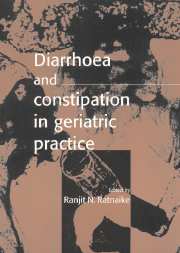Book contents
- Frontmatter
- Contents
- List of contributors
- Preface
- Acknowledgments
- Foreword by Gary R. Andrews
- I Defences of the aging gastrointestinal tract
- II Diarrhoea
- 3 Pathophysiology of diarrhoea
- 4 History and physical examination
- 5 The investigation of diarrhoea
- 6 Faecal incontinence
- 7 Drug-induced diarrhoea
- 8 Aetiology of infectious diarrhoea
- 9 Specific infectious conditions
- 10 An overview of management of infectious diarrhoea
- III Noninfectious clinical entities
- IV Constipation
- V Perspectives of altered bowel function
- Index
9 - Specific infectious conditions
Published online by Cambridge University Press: 17 August 2009
- Frontmatter
- Contents
- List of contributors
- Preface
- Acknowledgments
- Foreword by Gary R. Andrews
- I Defences of the aging gastrointestinal tract
- II Diarrhoea
- 3 Pathophysiology of diarrhoea
- 4 History and physical examination
- 5 The investigation of diarrhoea
- 6 Faecal incontinence
- 7 Drug-induced diarrhoea
- 8 Aetiology of infectious diarrhoea
- 9 Specific infectious conditions
- 10 An overview of management of infectious diarrhoea
- III Noninfectious clinical entities
- IV Constipation
- V Perspectives of altered bowel function
- Index
Summary
Bacterial overgrowth in the small intestine (blind loop syndrome, stagnant loop syndrome)
A form of diarrhoea peculiar to the elderly is associated with significant small bowel bacterial overgrowth. There is no evidence of systemic disease involving the small intestine nor anatomical abnormalities commonly associated with this entity (duodenal diverticula, small intestinal diverticulosis, surgical anastomoses, fistulas, strictures, mechanical obstructions). Bacterial overgrowth is reported to be a common cause of malabsorption in patients over the age of 80 years in whom there was no radiological or histological abnormality of the small intestine.
In the elderly, decreased nonimmunological and immunological defences of the gastrointestinal tract, discussed previously (see Chapters 1 and 2) predispose to bacterial overgrowth. The causes of hypomotility are systemic diseases and local conditions which involve the small intestine. The systemic conditions are hypothyroidism, diabetic autonomic neuropathy, amyloidosis, scleroderma and myotonia dystrophica. The local conditions include intestinal pseudo-obstruction, lymphoma and radiation enteritis.
Hypomotility due to hypothyroidism is perhaps not sufficiently recognized as a potential cause of bacterial overgrowth of the small intestine in the elderly. In a recent study on a group of elderly hypothyroid patients on thyroxine, the median orocaecal transit time increased from 75 to 135 minutes when thyroxine was withdrawn.
Another cause of bacterial overgrowth is intestinal pseudo-obstruction. This condition is often idiopathic although secondary causes are well documented (see Chapter 15).
- Type
- Chapter
- Information
- Diarrhoea and Constipation in Geriatric Practice , pp. 114 - 122Publisher: Cambridge University PressPrint publication year: 1999

